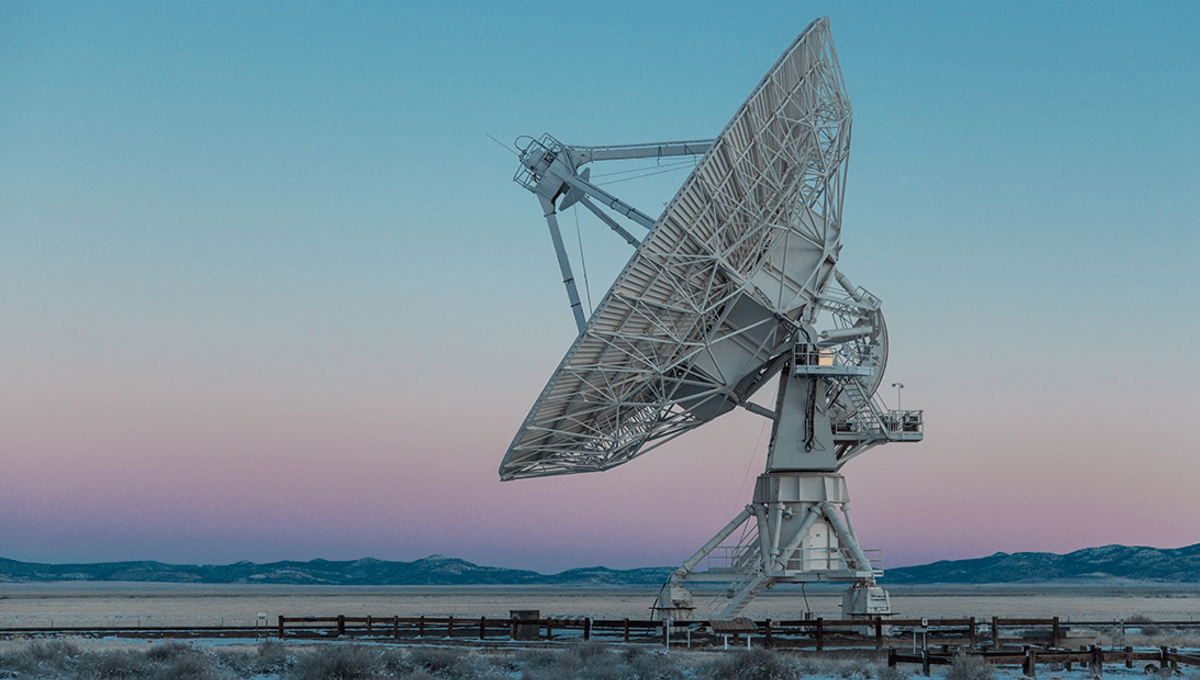
One of the greatest mysteries left for humans is the question; where is everybody else? Though there are around 200 billion trillion stars out there in the observable universe, we have found evidence for the existence of intelligent life on precisely one planet.
ADVERTISEMENT GO AD FREE
Many astronomers are trying to rectify this, searching for signs of advanced alien civilizations in the cosmos, including the Search for Extraterrestrial Intelligence (SETI). The good news is that they have a wealth of data available to them – so much, in fact, that it can be too much to process. It is this which SETI’s Commensal Open-source Multi-mode Interferometric Cluster (COSMIC) aims to tackle.
As outlined in a new paper, the team has created a “postprocessing pipeline to identify persistent sources of interference, filter out false positives, and search for signals not immediately identifiable as anthropogenic radio frequency interference”.
“Although using the world’s population and their excitement to filter out signals of interest through their collective enthusiasm is a feasible method for certain kinds of projects, we could quickly overload people if we did this with all of the data generated by COSMIC,” the team writes in their new paper. “Therefore, creating postprocessing pipelines through a series of logical steps that can be followed by humans or through machine learning/neural networks is necessary as we progress with our data collection.”
Using this software solution, the team has been able to identify one coherent signature coming from a technological source around 24 billion kilometers (15 billion miles) away, picked apart from the noise. That, of course, was NASA’s Voyager 1 spacecraft.
“The detection of Voyager 1 is an exciting demonstration of the capabilities of the COSMIC system,” Jack Hickish, Founder of Real-Time Radio Systems Ltd, said in a statement at the time. “It is the culmination of an enormous amount of work from an international team of scientists and engineers. The COSMIC system is a fantastic example of using modern general-purpose compute hardware to augment the capabilities of an existing telescope and serves as a testbed for technosignatures research on upcoming radio telescopes such as NRAO’s Next Generation VLA.”
ADVERTISEMENT GO AD FREE
Now, the researchers have been able to demonstrate the system using data from the Karl G. Jansky Very Large Array (VLA) sky survey in New Mexico.
“The targets for this project are typically stars,” Chenoa Tremblay, lead author on the paper, explained in a talk in 2023. “We know that now that most likely if you want to build an intelligent civilization you need low mass or intermediate mass stars to have that longer timeline in which they can develop in which planetary life has a potential for existing.”
While it did look for potential alien signals, the new study was largely aimed at testing the new system and figuring out its limitations. Nevertheless, it was pretty large, looking at 950,000 unique pointings of the VLA telescope.
“To test this postprocessing pipeline, we searched toward 511 stars from the Gaia catalog with coherent beams. This represents about 30 minutes of observation during VLASS, where we typically observe about 2000 sources [per hour] in the coherent beamforming mode,” the team writes in their paper. “We did not detect any unidentifiable signals, setting isotropic power limits ranging from 1011 to 1016 W.”
ADVERTISEMENT GO AD FREE
While it may be disappointing to not find any potential signals on the first pass, nobody was really expecting to. What is exciting is that the system could be used to quickly identify any unusual signals that come our way in the future.
“If any signal is identified by the postprocessing pipeline described in this paper or another, we have successful proposals with the VLA, the Very Long Baseline Array, the Allen Telescope Array, and the Parkes 64 m Telescope to follow up on those signals within a 1 week time frame,” the team writes, though they add that until processing becomes more automated, “the time frame for detecting signals for follow-up will take months”.
Nevertheless, the team is hopeful the new system could one day (fingers crossed) help identify other technological creatures out there in the universe.
ADVERTISEMENT GO AD FREE
The paper is published in The Astronomical Journal.
Source Link: What If We're Alone? Massive Search For Technosignatures In The Northern Hemisphere Finds Nothing